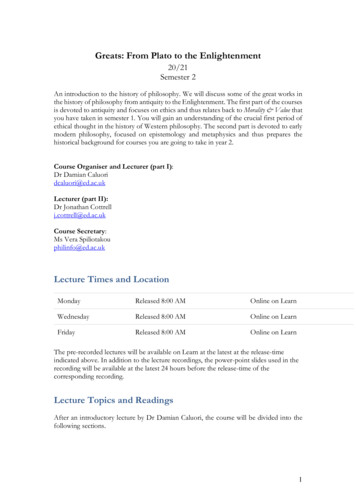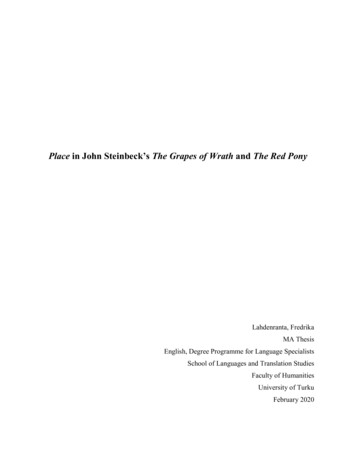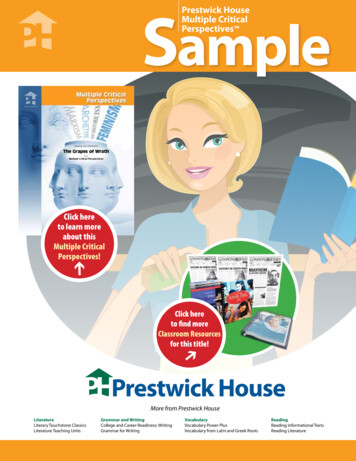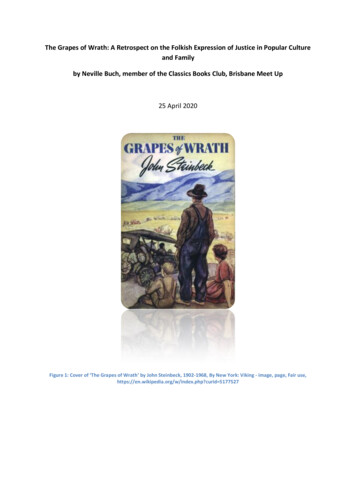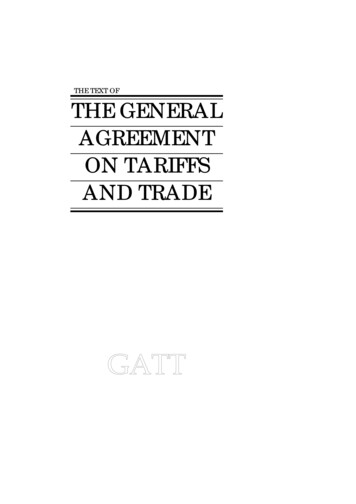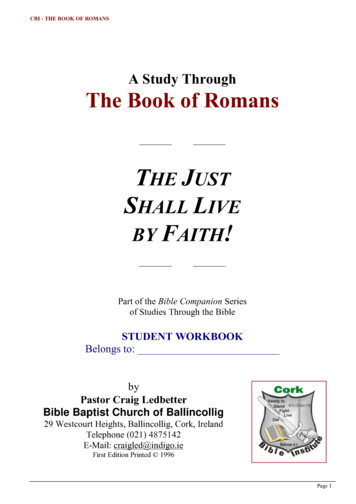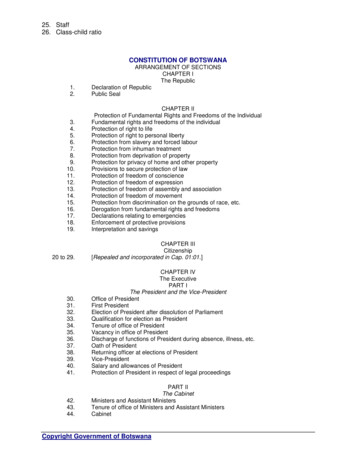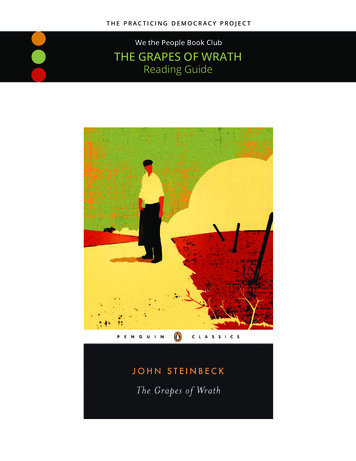
Transcription
REPUBLIC OF WRATH9780465002443-text.indd 17/2/20 3:23 PM
Also by James A. MoroneThe Devils We Know: Us and Them inAmerica’s Raucous Political CultureThe Heart of Power: Health and Politics in the Oval Office(with David Blumenthal)Hellfire Nation: The Politics of Sin in American HistoryBy the People: Debating American Government(with Rogan Kersh)The Democratic Wish: Popular Participation and theLimits of American GovernmentHealth Care Politics and Policy(edited with Daniel Ehlke)Healthy, Wealthy, and Fair:Health Care and the Good Society(edited with Lawrence Jacobs)The Politics of Health Care Reform:Lessons from the Past, Prospects for the Future(edited with Gary Belkin)9780465002443-text.indd 27/2/20 3:23 PM
REPUBLICOF WRATHHOW AMERICAN POLITICS TURNED TRIBAL,FROM GEORGE WASHINGTON TO DONALD TRUMPJAMES A. MORONENew York9780465002443-text.indd 37/2/20 3:23 PM
Copyright 2020 by James A. MoroneCover design by Alex CamlinCover copyright 2020 Hachette Book Group, Inc.Hachette Book Group supports the right to free expression and the value ofcopyright. The purpose of copyright is to encourage writers and artists to producethe creative works that enrich our culture.The scanning, uploading, and distribution of this book without permissionis a theft of the author’s intellectual property. If you would like permission touse material from the book (other than for review purposes), please contactpermissions@hbgusa.com. Thank you for your support of the author’s rights.Basic BooksHachette Book Group1290 Avenue of the Americas, New York, NY 10104www.basicbooks.comPrinted in the United States of AmericaFirst Edition: September 2020Published by Basic Books, an imprint of Perseus Books, LLC, a subsidiary ofHachette Book Group, Inc. The Basic Books name and logo is a trademark of theHachette Book Group.The Hachette Speakers Bureau provides a wide range of authors for speakingevents. To find out more, go to www.hachettespeakersbureau.com or call (866)376-6591.The publisher is not responsible for websites (or their content) that are not ownedby the publisher.Print book interior design by Trish Wilkinson.Library of Congress Control Number: 2020938784ISBNs: 978-0-4650-0244-3 (hardcover), 978-1-5416-7453-0 (ebook),978-1-5416-4619-3 (library ebook)LSC-C1099780465002443-text.indd 4876543217/2/20 3:23 PM
For Rebecca9780465002443-text.indd 57/2/20 3:23 PM
9780465002443-text.indd 67/2/20 3:23 PM
CONTENTSIntroduction: How American Politics Turned Tribal 1Part I THE PARTIES RISE1 Into the Temple of Liberty on the Shoulders of Slaves:The First Political Campaign (1800) 2 “Keep the Ball Rolling”: The First Campaign for theMasses (1840) 2961Part II CRACK-UP: THE CIVIL WAR AND AMERICA’S IDENTITY3 A Fire Bell in the Night: The Path to War (1852–1860) 954 Who Are We? The Civil War and Its Legacies(1860–1876) 127Part III THE POPULISTS AND THEIR LONG SHADOW5 Populism and the Rise of Active Government(1890–1900) 1756 The New Deal and the Origins of ContemporaryAmerica (1933–1948) 215Part IV AMERICAN POLITICS TURN TRIBAL7 The Election That Remade American Politics (1964) 8 We Win, They Lose: Tribal Politics at High Tide265(1968–2020) 293vii9780465002443-text.indd 77/2/20 3:23 PM
ContentsConclusion: What Next? 335Acknowledgments 355Notes 359Index 405viii9780465002443-text.indd 87/2/20 3:23 PM
INTRODUCTIONHow American Politics Turned TribalAmerican politics is loud, angry, and bristling with us versus them.The hostility between Republicans and Democrats seems to swellwith every election. In 2009, a Republican Congressman shouted“You lie!” at President Barack Obama on national television andraked in almost two million dollars in campaign contributionsthe following week. Seven years later, candidate Donald Trumpscreamed “Punch him in the face!” and a delirious white supporterat a campaign rally buffeted a young black man while others shoutedracial epithets. Democrats responded to President Trump’s electionwith annual “Not My President” marches. In the House of Representatives, 229 (out of 233) Democrats voted to impeach Trumpwithout a single Republican vote. Republican Party members callDemocrats “immoral” and “lazy.” Democrats fire back with “closedminded” and “dishonest.” On dating apps, people even spurn romance with partners from the opposite party—and that’s just as wellsince six out of ten parents would be unhappy if their children married someone from across the political divide.1But is there anything new in our screaming political divisions?Do they endanger the republic, as many observers fear? Or shouldwe all take a deep breath as American politics runs through justanother rowdy stretch? This book scans American history to explain19780465002443-text.indd 17/2/20 3:23 PM
REPUBLIC OF WRATHwhat is different about the passionate present—and how the pastmight guide us to toward a better future.Much of what we deplore today is nothing new: nastiness, violence, intolerance, fraud, twisting the election rules, bashing thegovernment, bias in the media, fistfights in Congress, and even aviolent coup in North Carolina. We have seen it all before.But, yes, there is something different about partisanship today,and it centers on two conflicts that each burned hot throughoutAmerican history—the long, hard battles that surrounded raceand immigration. In every generation, African Americans daredthe nation to honor its founding statements—and then braved theviolent backlashes. Clashes over slavery, segregation, racial equality, white privilege, and black lives profoundly shaped each twistand turn in the history of partisan politics. Immigrants faced a different set of challenges as they pressed for a place at the Americantable. Some Americans always seemed to fear the new arrivals—they came from the wrong places, represented inferior races, clungto un- American values, or professed dangerous religions. Spasmsof nativism met each immigrant generation. The conflicts over raceand immigration touch every aspect of the American story. Theyreshape the partisan debates because race and immigration createdisruptive new answers to the deepest question in American politics: Who are we?Today the partisan politics enfolding race and immigrationhave taken a new and unprecedented form. Historically, each ofthis country’s two major political parties defended—and, in turn, disdained—a different group on the margins of power. Nineteenth- century Democrats welcomed European immigrants and thrust ballots into their hands almost before they’d recovered from the seavoyage. But the Democrats were also the party of thumping whitesupremacy and stridently defended slavery, segregation, and whiteprivileges. On the other side, the conservative party was more enlightened about race but shouted “Fraud!” as the Irish or Sicilian29780465002443-text.indd 27/2/20 3:23 PM
Introductionor Jewish immigrants lined up to vote. At times, the parties brokeinto internal factions and the clash went on within their ranks. But,one way or another, the parties split up the nation’s most explosiveconflicts by picking different sides in the struggles over race andimmigration. Then, beginning in the 1930s, a new alignment beganto take shape.African Americans boldly joined the Democrats—the bastion ofwhite supremacy—and slowly, over decades, became a major forcewithin the party. A second seismic change came from immigration.Between 1970 and 2017, more than sixty million people arrived inthe United States, and the number of Americans born abroad leaptfrom less than one in twenty (in 1970) to almost one in seven peopletoday. By the mid-2000s, most naturalized immigrants had also begun to identify with Democrats. For the first time, black Americansand immigrants were members of the same party.An unprecedented coalition began to emerge. Democrats assembled African Americans, immigrants, and their liberal supporters.The modern Republican Party gathered people who consider themselves white and native. The most passionate differences ringingthrough American history are now organized directly into the parties. For the first time, all the so-called minorities are on one side.The politics grew more treacherous when the US Census Bureaucrunched the 2000 census results and made a controversial prediction: the United States would become majority-minority within ageneration. White people (who are not Hispanic) would make up46 percent of the population by 2050 and just 36 percent by 2060. Inthe past, the parties would have diffused the political impact—eachparty would have claimed one part of the rising majority. But thanksto the new party alignment, “majority-minority” sounds suspiciouslylike “majority-Democratic.”2Today’s party division threatens to turn every difference into aclash of tribes. Policy questions—what to do about health care ortaxes or global warming—become caught up in the us-versus-them39780465002443-text.indd 37/2/20 3:23 PM
REPUBLIC OF WRATHbattles. Both parties are deeply enmeshed in feelings about identitybecause each draws people who see themselves as fundamentally different from those on the other side. To be sure, Americans argueabout many different things—as they always have. But, generationafter generation, nothing has ignited political passions like the intertwined issues of race and immigration. And now the parties injectthose fervors directly into every political debate.3The history of partisanship reveals four additional twists to thepolitics of us versus them. The first springs from a curious silenceat the very heart of the republic: How should we run elections? Themen who wrote the Constitution shrugged off the question and leftit to the states. And there, from the start, the majorities ruthlesslychanged the rules to their own advantage. During the very first presidential campaign—when two parties each fielded a single candidate (in 1800)—seven out of the sixteen states changed or debatedchanging the election rules. As parties developed, they grew morebrazen about rigging the process. To this day, there is often no neutral arbiter to oversee elections, carve the districts, decide who qualifies to vote, determine registration procedures, specify how votesare cast, count the ballots, or adjudicate disputed returns. There arefew rules and almost no guidelines—just political muscle down inthe states and towns.Second, rigging the rules is simplified because, astonishingly,there is no right to vote in the United States. Again, it’s up to thestates. Take, for example, the Seventeenth Amendment to the Constitution which allegedly gave citizens the right to vote directly fortheir US senators. Well, not exactly. The amendment extends theballot to those entitled to vote for the “most numerous branch ofthe state legislatures”—in 1913, when the amendment was ratified,that meant black voters in New York but not North Carolina, andwomen in Nevada but not New Jersey. The Seventeenth Amendment is just one example of the long tradition: when it comes toelections, we defer to the states, and the states are not bound by a49780465002443-text.indd 47/2/20 3:23 PM
Introductionbasic right to vote. The Supreme Court invoked two centuries ofjurisprudence after the disputed 2000 election in its Bush v. Gore decision: “ The individual citizen has no constitutional right to vote forelectors of the president of the United States.” The fight over whovotes and how has kindled ferocious conflicts throughout Americanhistory. And the most intense battles have always blazed around African Americans and immigrants.4A third twist emerges from the familiar American resistance toa strong national government. A painful racial history lurks deepin the antigovernment tradition. There was always a white supremacy party ready to fight the feds. Each new national program facedthe same anxious filter: Might it give the federal government theauthority to someday, somehow, threaten slavery? Or segregation?Or white privilege? To be sure, many Americans opposed federalpower in the name of personal freedom and local democracy. Butthroughout American history, the honorable tradition of resistingthe central government in the name of liberty has drawn much ofits potency from an alliance with raw racial animosity. We’ll seethat link in every chapter. To the discomfort of many conservatives,the connection remains robust. An American majority (including46 percent of whites) considered President Trump a racist threeyears after he’d been elected. Future Republicans will face the hardjob of severing the long historical connection between resisting thenational government in the name of freedom and attacking it out ofracial hostility.5Finally, sexuality escalates the intensity of each fray. Racially divided societies always construct powerful taboos against interracialsex. If black men marry white women, the carefully fabricated racialdifferences will collapse. In the United States, the violently enforcedsexual taboos came with strict gender controls. Nineteenth-centuryobservers, like Alexis de Tocqueville, commented on the unusuallyrigid limits imposed on women in America—they were barred fromboth politics and markets. By the late 1830s, however, women had59780465002443-text.indd 57/8/20 3:15 PM
REPUBLIC OF WRATHbegun to challenge the restrictions. The gender rights campaignemerged directly from the fight against slavery. Supporters of bothracial rights and gender equality traditionally found a home in thesame political party. Today, gender coalesces with race and immigration to differentiate the parties. It’s an unprecedented configuration: African Americans, immigrants, and women lean to one party,white, native males toward the other.My focus on American identity—on race, immigration, and gender—is different from most accounts of our partisanhistory. The usual emphasis is rooted in economics. Most political historians emphasize tariffs and banks, labor and capital, boomsand busts, and, most important of all, the rise and fall of inequality.All these issues appear in the pages that follow—the battle betweenrich and poor, for example, powered the rise of active governmentand forms the great lost tradition for contemporary Democrats. Butas I pored over 220 years of newspapers, speeches, and party platforms, I was constantly struck by the tribal passions that intensifiedall those other conflicts, mutating from one generation to the nextand roaring into our own time.We begin with the hesitant rise of partisan politics. Americansfounded their republic with little thought about how the people(meaning affluent white men) might air their political differences.In fact, we can find the origins of this deep silence in one of the mostromantic tales about the young republic—the military coup that didnot happen.—————The ragtag American army had defeated the mostpowerful empire in the world. Now, in March 1783, they camped inNewburgh, New York, waiting for the peace treaty that would end69780465002443-text.indd 67/2/20 3:23 PM
Introductionthe American Revolution. But there was no cheer among the troopsbecause Congress, which did not have the power to raise taxes, hadnot paid them in months. The soldiers were cold, hungry, and impoverished. The officers had turned their blankets into coats, theirtroops didn’t even have blankets. What some of them did have werewives and children begging in the streets. When they mustered outof the military, the officers were facing hardship, poverty, and possibly even debtors’ prison.Wild plans filtered through the camp. An anonymous letter circulated among the officers and called on them to “assume a bolderTone.” Some wanted to head for the western forests and turn theirguns against this “country that tramples on your rights, disdains yourcries—& insults your distresses.” Others thought the army shouldmarch on Congress, demand their pay, and perhaps thrust one oftheir own into power.6The idea that the American Revolution might have ended ina coup sounds fantastic to us today. But that is exactly how revolutions normally end—strong men seize power. Some of GeneralGeorge Washington’s officers were ready and willing. The plotterscalled a secret meeting. “ The passions were all inflamed,” fretted ananxious Washington when he got wind of the cabal. He issued anorder, asserting his authority by changing the date of the meeting.Maybe waiting a few more days would cool things off, he wrote to amember of Congress.On March 15, hundreds of officers gathered on a windy bluffoverlooking the camp in a large building known as the Temple ofVirtue. A nervous Washington strode through his mutinous troopsto the front of the room and read a meticulously crafted speech.He implored them to back down, cheered them for their valor,and promised to always champion their interests. It was a beautifulspeech—so eloquent that it is still read by every cadet at the USMilitary Academy—but it didn’t work. The men remained sullenand unmoved.79780465002443-text.indd 77/8/20 3:16 PM
REPUBLIC OF WRATHWashington then unfolded a letter from a member of Congresspromising to win the soldiers their pay. Washington read, haltingly,and then stopped. Reaching into his tunic, he pulled out a new pair ofspectacles. The officers had never seen their general wearing glasses.The tall, powerful solider who had taken command eight years agowas getting old—he was now past fifty. “Gentlemen, you must pardon me,” muttered Washington, “I have grown gray in your serviceand now I find myself growing blind.” Stagecraft? Perhaps. But seeing their general’s infirmity worked like no words could. We knowfrom their letters home that some of these tough, battle- hardenedwarriors began to weep. That was the end of their rebellion.The usual moral of the famous story is simple. Good leaders likeWashington or his officers do not seek power; they do their job andgo home. Washington drew a different lesson: the new nation musthave a strong central government—it was the government’s weakness that almost led to the coup.7 Washington squared the circlebetween abjuring personal power on the one hand and calling fora strong government on the other by denouncing politics. Publicofficials, he thought, should do the right thing. Nothing excited hiswrath more than political parties or democratic societies (as the interest groups were called) trying to bend government toward theirown interests. Washington’s Farewell Address, traditionally read outloud across the country to mark his birthday, is an extended blastagainst parties and factions. The party spirit, he practically shouted,was a “horrible,” “baneful,” “frightful despotism” that would wreckour empire of liberty.8The men who wrote the Constitution disagreed on a lot of issues, but they all agreed with Washington about this—political parties were poison. Benjamin Franklin was so fearful of them that hemade a strange proposal at the Constitutional Convention. Do notpay people who serve in the executive department because, if wedo, political parties will rise up and grasp for the spoils of office.James Madison, the most sophisticated political thinker of them89780465002443-text.indd 87/2/20 3:23 PM
Introductionall, identified political faction as “the mortal disease under whichpopular governments have everywhere perished.” John Quincy Adams called parties “a baneful weed” that malicious Europeans hadplanted in the land of liberty. And as usual, Thomas Jefferson spunthe best aphorism: The party spirit, he wrote, was “the last degradation of a free and moral agent. If I could not get to heaven but witha party, I would not go there at all.”9There was just one problem with all that high-minded talk. Itimmediately proved impossible to run a republic without politicalparties. Americans disagreed about all kinds of things. Should thenational government be strong or weak? Should we despise Englandor France? Where should we put the capital? What should we doabout slavery? Or the Irish, French, and Haitian refugees that entered the country with pamphlets full of incendiary ideas? Whetherthe founders liked them or not, political parties gave the people(which, at the time, meant mainly wealthy white men) their say.Parties lined up popular support behind the politicians who werewrestling over these issues.Jefferson may indeed have ended up in hell because he and Madison quickly rallied opponents of strong national government intosomething that looked a lot like a party—complete with a newspaper digging up dirt about the other side (conveniently funded byJefferson’s State Department). Their rivals, led by Alexander Hamilton and John Adams, organized too. And in no time those infernal parties were part of the political scene. Everyone acknowledgedthat what they were doing was wrong—but, what else could theydo? Each side organized a faction because they were convinced theirrivals would ruin the republic. Each side believed its passage to thedark side would be temporary. They all expected to return to theirnonpartisan ways as soon as they had saved the nation from theirirresponsible competitors.As a result of their nonpartisan illusion, the founding generationleft behind no wisdom about partisan politics—and not many rules.99780465002443-text.indd 97/2/20 3:23 PM
REPUBLIC OF WRATHPolitical parties were not seriously discussed at the ConstitutionalConvention, were not mentioned in the Constitution, and scarcelyappear in The Federalist Papers (editorials which explained the Constitution and pushed for ratification in New York). The Constitution shuffled most of the details off to the state governments. There,the majorities schemed up all kinds of ways to keep people awayfrom the ballot box if they were not deserving or not ready or noton our side.10Efforts to bar political rivals from the ballot run through theyears: eligibility rules, registration requirements, violence, literacytests, poll taxes, gerrymanders, barriers for felons, barriers for formerfelons, shifting ID laws—on and on it rolls through US history, thepolitics of who votes and how easily. The rigmarole that surroundsvoting would rise through the years, especially when it mixed withthe creedal politics of race and immigration.11The very first contested election, in 1800, established the traditional party attitudes toward race and immigration.President John Adams, who had succeeded George Washington,was running for reelection with the Federalist Party against ThomasJefferson and the Democratic-Republicans.** A word about party names: The Jeffersonians generally referred to themselves as Republicans. Later, they came to be called Democrats, the samename by which the party is known today. Historians have tidied things upby calling the Jeffersonians “Democratic-Republicans,” though the partymembers did not use the term themselves. On the other side, the FederalistParty soon vanished, and most members (and their attitudes) drifted intothe Whig Party, in the 1830s, and, from there, to the Republicans, in themid-1850s. Of course, the nineteenth-century parties look very differentthan their twenty-first-century counterparts, but by the election of 1856, thetwo major parties were the Democrats and the Republicans.109780465002443-text.indd 107/2/20 3:23 PM
IntroductionPresident Adams and the Federalists aspired to a classical, orderlyrepublic where people deferred to their leaders. Instead, they faceda brawling, partisan uproar intensified by refugees who were firedup by the egalitarian ideals of the French Revolution and loudlyscorned the president for acting like a king. The Federalists tried toimpose order with the Alien Acts, which authorized governmentofficials to deport foreigners without testimony or trial. They alsopassed a sedition law that established prison sentences for news paper editors who dared to impugn the government. The blunderinglegislation, meant to hush political debate, had exactly the oppositeeffect. The laws became major issues in the boisterous election of1800. For the next sixty years, the Democrats continued to stand upfor immigrants and mocked their rivals for clinging to the “spirit”of the Alien and Sedition Acts (as the Democratic Party platformof 1852 put it), even long after the laws—and the Federalists—hadvanished into history.12The clash over the Alien Acts remains infamous to this day.However, the 1800 election also focused on slavery, and on this issue, the parties took very different positions. Now, it was the Federalists who were more tolerant. Throughout the 1790s, Americanshad anxiously followed the slave rebellion shaking Saint-Domingue,the French colony in the Caribbean that would later become Haiti.In 1791, the slaves rose up and overthrew their French masters.When the English tried to take advantage of the chaos and seizecontrol of the island, the rebel slaves fought and defeated them (theBritish forces suffered almost as many casualties in the conflict onHaiti as they had during the American Revolution). After defeatingthe British, the rebel leader, Toussaint Louverture, proposed a tradealliance to the Adams administration. The administration agreed in1799, and the fledgling US Navy even went so far as to shell one ofToussaint’s rivals. The Democrats, who had been so welcoming tothe European refugees, were horrified by an alliance with formerslaves. What would happen, asked Jefferson, when Haitian vessels119780465002443-text.indd 117/2/20 3:23 PM
REPUBLIC OF WRATHlanded in southern ports with black crews who had won their freedom with guns and knives? American slaves might be inspired tolaunch a revolt of their own.Sure enough, even as voters in some states were casting ballots in1800, a large and well-organized slave insurrection was discoveredin Virginia. The Democratic-Republican newspapers blamed thisterrifying conspiracy on the Federalists’ rash alliance with a nationof slaves who, as the party members constantly reminded everyone,had won their liberty by murdering their masters.A pattern had already emerged. The conservative party (the Federalists, followed by the Whigs and the Republicans) was more tolerant toward African Americans. Over time, they offered a politicalhome to most black voters, abolitionists, and civil rights activists.But aliens vexed them. The conservatives continually invented newways to keep the newcomers away from politics and power. Onthe other side, the Democrats championed European immigrants(Asians would be a different matter), but they bitterly denouncedefforts to meddle with slavery, states’ rights, segregation, or whitesupremacy.The United States finally cast aside Washington’swarnings and built unabashed, all-in mass parties for the white malemasses in the 1820s and 1830s. They hit the political scene with anarresting claim—parties could calm the rising storm over slavery.Martin Van Buren—a short, smooth-talking, self-educated, gaudilydressed, flamboyantly whiskered, political genius from New York—sold the idea to southern leaders. A proper party, purred Van Buren, would break the northern “clamor against Southern Influenceand African slavery” by channeling political competition into a focus on the plums (or jobs) that would be distributed after electionvictories.13129780465002443-text.indd 127/2/20 3:23 PM
IntroductionThe very fear that Benjamin Franklin had voiced at the Constitutional Convention, when he suggested not paying federal officials,now mutated into a way to protect the republic from the slaverydebate. The party faithful would follow their party chieftains andfight for the spoils of office instead of relying on such mischievousmotives as regional feeling or personal judgment. Americans builttheir first mass party partially to blunt the great tribal issue of theday. It worked for, roughly, three decades until the slavery questionsimply got too powerful and broke the parties.As slavery moved to the center of American politics, each partygroped for ways to keep its northern and southern members together. The Democrats managed, for a time, by simply leaving theissue to the states. No one, they insisted, had any right to meddlewith the states’ control over their “domestic institutions.” But theDemocrats soon undermined their tidy solution. In the 1840s, theybegan to proclaim that it was the nation’s providential destiny tospread across the entire continent. But each new acre brought withit an inescapable question—would this territory be slave land or freesoil? States’ rights offered no simple solution, and the party beganto strain over the question that it had pushed before the country.14The Whigs never found any answer to the slavery question andwhen it became the dominant issue, the party cracked into northernand southern factions. Most northern Whigs migrated to the Republican Party—it opposed the spread of slavery but also includeda cadre of nativists fearful of immigrants. The new party’s attitudesabout race and immigration kept getting entangled with one another.For example, after the Civil War, in 1869 a Republican Congressoverrode furious Democratic objections and passed the FifteenthAmendment extending suffrage to black men—at the time, it wasa bold and radical move. But Republican efforts to empower blackvoters in the South clashed with Republican efforts to control immigrants. A forceful version of the Fifteenth Amendment would have139780465002443-text.indd 137/2/20 3:23 PM
REPUBLIC OF WRATHdirectly protected the right of all citizens to vote, but it won only fivevotes in the Senate. The proposal failed to attract more Republicansupport because it would have ruled out the literacy tests and polltaxes that Republicans deployed to limit Irish voters in the Northeast. Other senators, from both parties, feared that a powerful votingrights amendment might empower Chinese immigrants in the west.The actual Fifteenth Amendment was more constricted and only forbade states from denying any citizen the right to vote “on account ofrace, co
screamed "Punch him in the face!" and a delirious white supporter at a campaign rally buffeted a young black man while others shouted racial epithets. Democrats responded to President Trump's election with annual "Not My President" marches. In the House of Repre-sentatives, 229 (out of 233) Democrats voted to impeach Trump
